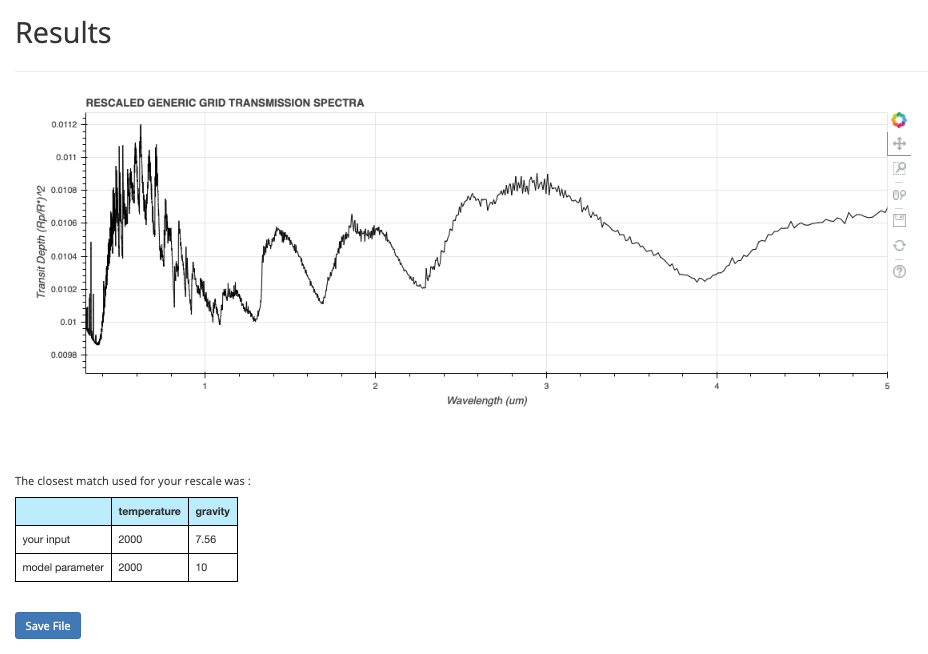ExoCTK Forward Modeling Tool
The Forward Modeling tool, used for planning JWST exoplanet observations, provides an interface to generate and extract theoretical transmission spectra of exoplanets from the grids published by Fortney et al. (2010) as used in Sing et al. (2016) and Goyal et al. (2018). This web-based tool is part of the STScI's Exoplanet Characterization ToolKit (ExoCTK) suite of web-based services.
On this page
See also: PandExo: The Exoplanet ETC
When writing JWST proposals for transiting exoplanet science, an important component of the process involves having exoplanet atmospheric models available in order to use them to predict what JWST might be able to observe. The atmospheric forward modeling tools of STScI's Exoplanent Characterization Toolkit (ExoCTK) provide a simple interface for retrieving atmospheric models from the grids of Fortney et al. (2010) (as used by Sing et al. 2016) and Goyal et al. (2018), useful for proposal preparation.
Predicting the types of atomic and molecular signatures that JWST will be able to observe in the different wavelength ranges offered by its instruments is crucial for proposal preparation, as it motivates not only the particular choice of the instrument but also the overall observational setup in terms of the required signal to noise to retrieve said features.
Fortney's grid
Words in bold are GUI menus/
panels or data software packages;
bold italics are buttons in GUI
tools or package parameters.
- The first entry is the expected planetary temperature (Planet Temp (K), in Kelvins).
- The second is the Chemistry Type, where the user can choose between chemical equilibrium models that either include or exclude titanium oxide (TiO).
- The third is the type of clouds or scattering (Clouds or Scattering) the user wants to implement in the modeling, which follows the prescription defined in Sing et al. (2016).
For clouds, a wavelength-independent cross-section component is included to emulate grey clouds, with 1× (Weak Cloud), 10× (Medium Cloud), and 100× (Strong Cloud) the cross section of molecular hydrogen gas at 350 nm. For scattering, the modeling assumes Rayleigh scattering opacity (i.e., a variation of the cross section with the inverse of the wavelength to the 4th power) with an amplitude 10× (Weak Rayleigh), 100× (Medium Rayleigh), and 1,000× (Strong Rayleigh) the amplitude of the cross section implied by Rayleigh scattering produced by molecular hydrogen gas.
Finally, the user needs to enter the Planet Mass, Radius and Stellar Radius in order to generate a transmission spectrum for the planet of interest. A visual of the Fortney Grid form, with the parameters mentioned above, is shown in Figure 1.
To save the model, the user can click on the Save File button which will in turn download the current atmospheric model in its original units in a format ready to be ingested to tools like, e.g., PandExo.
Generic grid
The web-based interface for the Generic Grid allows the user to rescale the transmission spectra published in Goyal et al. (2018) for each specific combination of planetary parameters. The user enters a set of parameters that define the atmospheric structure of the exoplanet, as shown in Figure 3.
- The first set are the Scaling Parameters which define the parameters used to scale the Goyal et al. (2018) spectra: in particular, the atmospheric temperature (in Kelvins) and the planetary gravity (in m/s2).
- The second set of parameters are the Stellar and Planetary Radii; the former has to be defined in solar units and the second in units of Jupiter radii.
- Finally, the user also has to select the Standard Model Parameters, which define the overall handling of the atmospheric properties and include the following parameters:
- Type of condensation, either local or rainout. Rainout condensation assumes material which condenses is depleted from all layers of the model in the condensate forming layer and above. Local condensation assumes material which condenses is depleted independently in each layer of the model atmosphere.
- Metallicity of the planet.
- Carbon-to-oxygen ratio.
- Type of scattering to be used to generate the models, ranging from 1 (which corresponds to normal scattering) to 1100 (corresponds to enhanced scattering from the optical to IR).
- Type of clouds to be used to generate the models, with values from 0.00 to 1.00
References
Fortney, J. J., et al. 2010, ApJ, 709, 2, 1396-1406.
Transmission Spectra of Three-Dimensional Hot Jupiter Model Atmospheres
Goyal, J. M., et al. 2018, MNRAS, 474, 4, 5158-5185.
A library of ATMO forward model transmission spectra for hot Jupiter exoplanets
Sing, D., et al. 2016, Nature, 529, 7584, 59-62.
A continuum from clear to cloudy hot-Jupiter exoplanets without primordial water depletion



